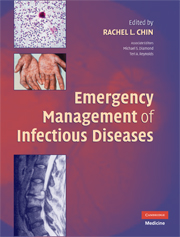Book contents
- Frontmatter
- Contents
- Preface
- Contributors
- Part I Systems
- Part II Pediatrics
- Part III Special Populations
- 50 Bites
- 51 Infections in Oncology Patients
- 52 Ectoparasites
- 53 Fever in Pregnancy
- 54 Fever in the Returning Traveler
- 55 Infectious Complications of Injection Drug Use
- 56 Blood or Body Fluid Exposure Management and Postexposure Prophylaxis for Hepatitis B and HIV
- 57 Postoperative Infections
- 58 Postpartum and Postabortion Infections
- 59 The Febrile Post-Transplant Patient
- 60 Rabies
- 61 Septic Shock
- 62 Sickle Cell Disease
- 63 Tetanus
- Part IV Current Topics
- Part V Overview of Antibiotics
- Part VI Microbiology/Laboratory Tests
- Part VII Infection Control Precautions
- Index
- References
52 - Ectoparasites
from Part III - Special Populations
Published online by Cambridge University Press: 15 December 2009
- Frontmatter
- Contents
- Preface
- Contributors
- Part I Systems
- Part II Pediatrics
- Part III Special Populations
- 50 Bites
- 51 Infections in Oncology Patients
- 52 Ectoparasites
- 53 Fever in Pregnancy
- 54 Fever in the Returning Traveler
- 55 Infectious Complications of Injection Drug Use
- 56 Blood or Body Fluid Exposure Management and Postexposure Prophylaxis for Hepatitis B and HIV
- 57 Postoperative Infections
- 58 Postpartum and Postabortion Infections
- 59 The Febrile Post-Transplant Patient
- 60 Rabies
- 61 Septic Shock
- 62 Sickle Cell Disease
- 63 Tetanus
- Part IV Current Topics
- Part V Overview of Antibiotics
- Part VI Microbiology/Laboratory Tests
- Part VII Infection Control Precautions
- Index
- References
Summary
INTRODUCTION
Ectoparasitosis includes all infestations where parasites live in or on human skin. Most human ectoparasites are arthropods, primarily insects and arachnids, including ticks. Many ectoparasite infestations result in significant morbidity and yet go unrecognized in the acute care setting. Failure to treat affected patients leads to spread of ectoparasites through vulnerable populations both inside and outside the hospital. Recognition and treatment of ectoparasitosis (including resistant strains of pediculosis and scabies) is particularly important because these infestations are increasing geographically and within traditionally less vulnerable populations.
GENERAL ECTOPARASITE EPIDEMIOLOGY
Ectoparisitoses are most prevalent in resource-poor populations, including the homeless, immigrants, refugees, the incarcerated, the malnourished, and those who are underinsured and uninsured. The worldwide prevalence of scabies has been estimated at 300 million cases and is expanding. Crusted (or Norwegian) scabies are now an important nosocomial disease resulting in a large number of bed closures in intensive care units (ICUs) and wards across the United States. Head lice result in the loss of 12 to 24 million school days for U.S. children annually. Emerging resistance makes control more difficult, and incidence is also increasing due to the expanded use of steroids for asthma, arthritis, lupus, and other inflammatory diseases. (See Table 52.1.)
SCABIES
Clinical Features
Scabies is a common ectoparasitic infestation caused by the mite Sarcoptes scabiei. They are also known as “human itch mites.”
- Type
- Chapter
- Information
- Emergency Management of Infectious Diseases , pp. 325 - 334Publisher: Cambridge University PressPrint publication year: 2008

